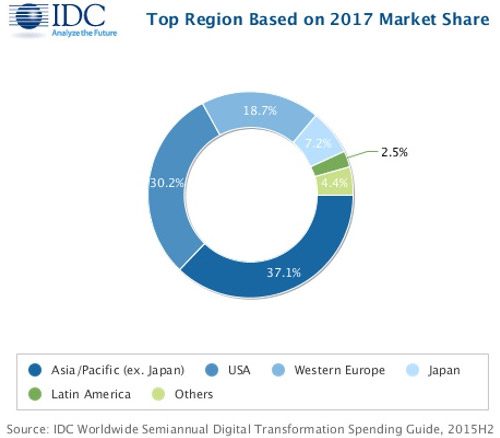IDC explores the economic impact of digital transformation in its latest forecast, and the company’s analysis of the market hints at potential boom times for technology vendors over the next few years.
More than just a trend, digital transformation is informing the business strategies of practically all top-level executives. Last summer, a survey from QuickBase and Market Cube found that a whopping 97 percent of C-suite executives described digital transformation as a top priority.
This year, businesses are expected to spend $1.2 trillion on digital transformation technologies, a nearly 18-percent gain compared to 2016, said the analyst firm. By 2020, that figure will hit a whopping $2 trillion, representing a five-year compound annual growth rate (CAGR) of 17.9 percent.
IT services, connectivity and application development and deployment will generate nearly half of all digital transformation technology spending in 2017.Cloud infrastructure will grow briskly as 2020 approaches with a CAGR of 29.4 percent), followed by business services (22 percent) and applications (21.8 percent).
Few industries will be left untouched by the digital transformation trend.
“Changing competitive landscapes and consumerism are disrupting businesses and creating an imperative to invest in digital transformation, unleashing the power of information across the enterprise and thereby improving the customer experience, operational efficiencies, and optimizing the workforce,” observed IDC program director Eileen Smith, in a statement. “In 2017, global organizations will spend $1.2 trillion on digital transformation with discrete and process manufacturers contributing almost 30 percent of this spending, while the fastest growth will come from retail, healthcare providers, insurance, and banking.”
Earlier this year, IDC said digital transformation initiatives at banks and factories would help lift the IT market. By 2020, worldwide IT spending will approach $2.65 trillion, up from an estimated $2.4 trillion this year. Combined, manufacturing firms and financial firms are expected to generate 30 percent of all IT sales throughout the forecast as they forge ahead in their efforts to create agile, digital-enabled workplaces.
Regionally, Asia-Pacific excluding Japan will lead the market in 2017 by generating 37 percent of all digital transformation spending where manufacturers and professional services providers will primarily drive demand.
The U.S. will take second place with just over 30 percent of all spending, followed by Western Europe with just under 19 percent. In the U.S. professional services, discrete manufacturing, transportation and professional services firms will be the biggest spenders.
Pedro Hernandez is a contributing editor at Datamation. Follow him on Twitter @ecoINSITE.



